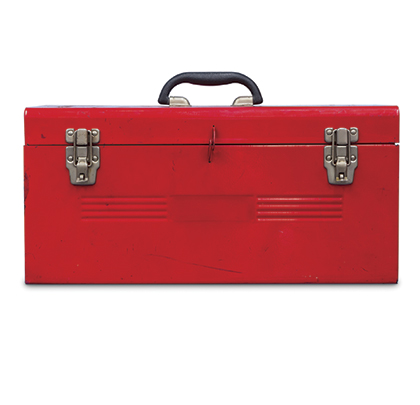For safety to be an integral part of a company’s culture, it needs to be treated importantly every day. That’s means showcasing safety protocols with signage in prominent places and talking about safety issues weekly during “toolbox talks” to educate and inform the workforce. Are you currently holding toolbox talks with your workers? Do you need safety topic ideas and talking points? A good resource for material is the Center for Construction Research and Training (CPWR), the research, training, and service arm of the Building and Construction Trades Department. CPWR works to reduce or eliminate safety and health hazards construction workers face on the job. The following are TOOLBOX TOPICS to share with your crews:
ASPHALT FUMES
Asphalt has been known to cause minor health effects such as headaches, nausea, and drowsiness. It has even been linked to lung cancer. There are ways to protect oneself from asphalt fumes. An asphalt kettle operator gets continuous exposure to fumes that escape from the kettle during operation and occasional exposures when opening the lid to fill or load the kettle. Currently, there is no OSHA standard for asphalt fumes, but respirator use may be called for if the fumes exposure concentrations are below the NIOSH Recommended Exposure Limit. To prevent injuries, it’s important to practice safe asphalt work. Make sure to place the kettle downwind where the operator and others will be least exposed. Also, set the kettle on firm, level ground to avoid spilling its contents or tipping the kettle over. Lastly, keep a fully charged ABC-type fire extinguisher near the kettle.
AERIAL LIFTS
Aerial lifts are vehicle-mounted devices that allow workers to perform work above the ground. Construction workers involved in aerial lift accidents could face falls, broken bones, and death. Approximately26 construction workers die each year from using aerial lifts and more than half of the deaths involve boom-supported lifts, such as bucket trucks and cherry pickers. The remaining deaths are caused by electrocutions, falls, and tip-overs involving scissor lifts. To avoid incidents, set outriggers, brakes, and wheel chocks even on level surfaces. If working near traffic, set up work zone warnings using cones and signs to alert traffic. Always stand on the floor of the bucket; don’t climb on or lean over guardrails.
FORK LIFTS
OSHA estimates that there are 680,400 forklift accidents each year. It is important that only trained and certified operators drive a forklift, otherwise someone can seriously injure themselves. Also use seatbelts if they are available. Make sure to use extreme caution on grades or ramps. Lastly, don’t raise and lower the forks while the forklift is moving.
CARPAL TUNNEL
Carpal tunnel syndrome (CTS) is a painful condition that results when an important nerve is regularly disturbed. CTS starts slowly with pain, weakness, or numbness in the hand and wrist and eventually the pain moves up the arm to other parts of the body. CTS is viewed as one type of repetitive motion injury. To prevent CTS, always wear gloves to lessen the shock when using vibrating tools. Make sure you rest your hands periodically so they don’t get too much continuously. Finally, keep your wrists in a neutral position.
COLD WEATHER
Extended exposure to freezing or cold temperatures can result in health problems such as trench foot, frostbite, and hypothermia. Uncontrolled shivering, slurred speech, clumsy movements, fatigue, and confused behavior are all signs of cold weather related health problems. Make sure workers wear proper clothing for cold, wet, and windy conditions. Layer clothing to adjust to changing temperatures and wear a hat and gloves. Using the buddy system is good since workers will be able to recognize the danger signs in the other worker.
WORKPLACE STRESS
Job stress is the physical and emotional harm that occurs when the requirements of a job do not match the capabilities, resources, or needs of the worker. If can lead to poor health and even injury. It’s important to tell your supervisor or employer haw you feel. Job stress can be reduced by taking care of yourself like exercising. Seek medical attention if you suffer from frequent headaches, inability to sleep, difficulty concentrating, upset stomach, and short temper.
NIGHT SHIFT
Workplace injury records show that more accidents happen on night shifts than day shifts. There are obvious hazards like the lack of light, but there are some that aren’t. Weather patterns are harder to track at night and rain can cause surfaces to be slick quickly. To ensure workplace safety at night, install low-level transitional lighting in advanced warning areas and termination areas to ease motorists’ adjustment to changing light conditions. Make sure to increase the size of traffic control devices, reflective material, and lettering to improve driver recognition.
HEARING PROTECTION
Hearing loss can occur if exposed to too much noise. Not only can hearing loss occur, but the noise can be distracting and warnings can be lost among the noise. Loud noises damages irreparable nerves in the ears. It’s important to know how to properly insert disposable foam war plugs since there is one way that makes them beneficial. Also identify equipment and work areas where signs can be posted to make other workers aware of high noise areas and move noise sources such as compressors away from the workers.
As an employer, you want to look at for your employee’s safety so that they aren’t seriously injured or become a liability. Following these tips will help make a safer work environment and a more productive business. ■
For More Information: For more information about CPWR and the resources for toolbox safety talks, visit www.cpwr.com.
_________________________________________________________________________
Modern Contractor Solutions – February 2016
Did you enjoy this article?
Subscribe to the FREE Digital Edition of Modern Contractor Solutions magazine.

Toolbox Talks


